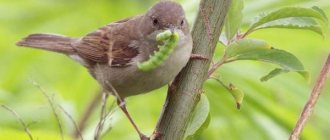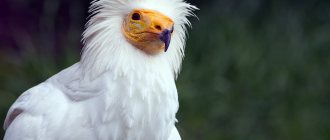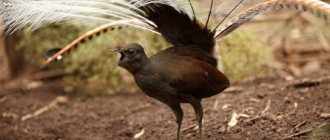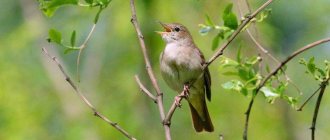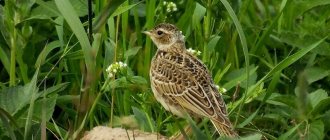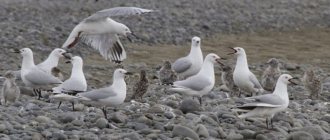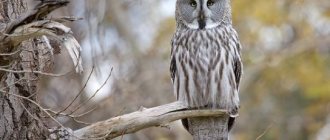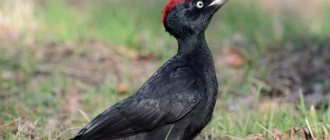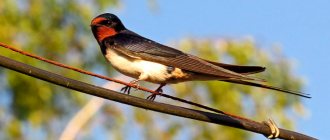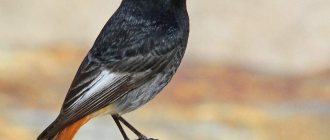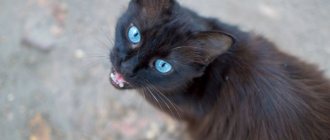- Wild animals
- >>
- Birds
In the starling family there is one curious bird - the mynah , which causes mixed reactions in people. Some people adore her for her amazing ability to repeat different sound combinations (including people's speech). Others fight against mynas, considering them their worst enemies, causing damage to agricultural land. What exactly are mynas and what is their role in the ecosystem of different countries?
REPRODUCTION
Urban mynas usually nest under the roofs of houses. Birds living outside human settlements prefer the crowns of coconut trees, natural depressions in tree trunks and cavities that were previously used by other birds or squirrels. The mynahs return to the place they like over the course of several years. Mynah nests are woven from grass and branches. Birds also use paper, thread and even plastic film as additional building material. The male and female are engaged in the construction of the nest and raising the offspring together. After 13-14 days, the chicks hatch from the eggs. After a few weeks, they begin to fly. Parents feed the chicks for another week after leaving the nest.
Recommendations
- BirdLife International (2012). " Acridotheres tristis
".
IUCN Red List of Threatened Species
.
2012
. Retrieved November 26, 2013.CS1 maint: ref=harv(link)Old form URL - "Archival copy." Archived from the original on 2015-02-28. Retrieved 2014-04-27.CS1 maint: zipped copy as title (link)
- ^ a b c
Lowe, S., Brown, M., Bougelas, S., & de Porter, M. (2000, updated 2004). The World's 100 Worst Invasive Alien Species: Selected from the Global Invasive Species Database Archived 2017-03-16 at the Wayback Machine. Invasive Species Specialist Group (ISSG), a specialist group of the World Conservation Union (IUCN) Species Survival Commission (SSC), Auckland. - ^ a b
"ABC Wildwatch". abc.net.au. Archived from the original on 2012-11-09. Retrieved 2012-08-07. - Brisson, Mathurin Jacques (1760). Ornithologie, ou, Méthode contenant la division des oiseaux en ordres, divisions, genres, especes & leurs varétés
(in French and Latin). Volume 2. Paris: Jean-Baptiste Bosch. pp. 278–280, table. 26 pics. 1. The two stars (**) at the beginning of the section indicate that Brisson based his description on examination of the specimen. - ^ a b
Allen, J. (1910).
"A comparison of the bird genera of Brisson with the birds of Linnaeus". Bulletin of the American Museum of Natural History
.
28
: 317–335. HDL:2246/678. - Linnaeus, Karl (1766). Systema naturae: per regna tria natura, classes secundum, ordinal, genera, species, cum characteribus, differentials, synonyms, loci
(in Latin). Volume 1, part 1 (12th ed.). Holmiae (Stockholm): Laurentii Salvii. paragraph 167. - Mayr, Ernst; Greenway, James S. Jr., ed. (1962). Checklist of birds of the world
. Volume 15. Cambridge, MA: Museum of Comparative Zoology. pp. 112–113. - Jobling, J. (2018). del Hoyo, J.; Elliott, A.; Sargatal, J.; Christie, D.A.; de Juana, E. (ed.). "The Key to Scientific Names in Ornithology". Directory of the World's Living Birds
. Lynx Editions. Retrieved May 11, 2022. - Vieyot, Louis Jean Pierre (1816). Analyze d'une Nouvelle Ornithologie Élémentaire
(In French). Paris: Deterville / himself. paragraph 42. - Gill, Frank; Donsker, David, ed. (2018). “Nuthatches, wallbows, poison dart frogs, mockingbirds, starlings, bagpipes.” World Bird List, version 8.1
. International Union of Ornithologists. Retrieved May 11, 2022. - ^ a b c d f g gram hour i j
Ali, Salim;
Ripley, S. Dillon (2001). Handbook of Birds of India and Pakistan, Volume 5
(2nd (paperback) ed.). India: Oxford University Press. p. 278. ISBN 978-0-19-565938-2. - ^ a b
Rasmussen, Pamela S.;
Anderton, John S. (2005). Birds of South Asia - Ripley's Guide (Volume 2)
. Smithsonian Institution, Washington & Lynx edicions, Barcelona. pp. 584, 683. ISBN 978-84-87334-66-5. - Rasmussen, P. C. and J. C. Anderton (2005). Birds of South Asia: Ripley's Guide.
Volume 2 . Smithsonian Institution and Lynx Editions. item 584. - Griffin, Andrea S. (2008). "Social learning in Indian mynas, Acridotheres tristis
: the role of distress calls."
Animal behavior
.
75
(1):79–89. doi:10.1016/j.anbehav.2007.04.008. S2CID 53184596. - ^ a b
Mahabal, Anil;
Vaidya, V. (1989). “Diad Rhythms and Seasonal Changes in the Indian Myna Roost. Acridotheres tristis
(Linnaeus)."
Proceedings of the Indian Academy of Sciences (Animal Science)
.
98
(3):199–209. Doi:10.1007/BF03179646. S2CID 129156314. Retrieved January 22, 2011. - ^ a b
“Common myna.” Retrieved December 23, 2007. - "Common Myna - Audubon Field Guide." Audubon. 2014-11-13. Retrieved March 2, 2016.
- "The Ubiquitous Javan Myna." Bird Ecology Study Group, The Nature Society (Singapore)
. Besgroup.blogspot.com. Retrieved October 25, 2007. - Pell, A.S.; K. R. Tiedemann (1997). "Ecology of the common myna in urban nature reserves in the Australian Capital Territory" (PDF). Emu
.
97
(2): 141–149. Doi:10.1071/MU97018. - Pell 1997, p.146
- Pell 1997, p.141
- Bomford, M.; Ron Sinclair (2002). "Australian avian pest research: impacts, management and future directions" (PDF). Emu
.
102
: 35. doi:10.1071/MU01028. S2CID 83464835. - Chowdhury A. (1998). "Common Myna feeding a Koel chick." Journal of the Bombay Natural History Society
.
95
(1):115. - Mahabal, Anil (1991). "Time budget of activity of the Indian Mynah Acridotheres tristis
(Linnaeus) during the breeding season."
Journal of the Bombay Natural History Society
.
90
(1):96–97. Retrieved January 22, 2011. - Pande, Satish; Tambe, Salil; Clement, Francis M; Sant, Niranjan (2003). Birds of the Western Ghats, Kokan and Malabar (including birds of Goa)
. Mumbai: Bombay Natural History Society and Oxford University Press. pp. 312, 377. ISBN 978-0-19-566878-0. - Lowe, Kathy A.; Taylor, Charlotte E.; Major, Richard E. (2011-10-01). “Do Common Minas Compete Significantly with Native Birds in Urban Environments?” Journal of Ornithology
.
152
(4):909–921. Doi:10.1007/s10336-011-0674-5. ISSN 0021-8375. S2CID 3153551. - Matthew, D.N.; Narendran, T.K.; Zachariah, V. J. (1978). "A comparative study of the feeding habits of some Indian bird species affecting agriculture." J. Bombay Nat.
Hist. Soc .
75
(4):1178–1197. - Mahabal, Anil; Bastawade, D. (1991). "Mixed associates of the Indian Myna Acridotheres tristis
in the city of Pune, India."
Pavo
.
29
(1 & 2): 23–32. Retrieved January 22, 2011. - Mahabal, Anil (1992). "Diurnal intra- and interspecific communities of Indian mynes". Biovigyanam
.
18
(2): 116–118. Retrieved January 22, 2011. - Mahabal, Anil; Bastawade, D.B.; Vaidya, V. (1990). “Spatial and temporal fluctuations in the population size of the common mynah. Acridotheres tristis
(Linnaeus) in and around an Indian city."
Journal of the Bombay Natural History Society
.
87
(3):392–398. Retrieved January 22, 2011. - Mahabal, Anil (1993). “Seasonal changes in the Indian mynah flock. Acridotheres tristis
(Linnaeus)."
Biovigyanam
.
19
(1 & 2): 55–64. Retrieved January 22, 2011. - Mahabal, Anil (1997). "Community in Common Mynas and its functional significance." Journal of the Bombay Natural History Society
.
94
(2):342–349. Retrieved January 22, 2011. - Mahabal, Anil (1993). "Cooperative display behavior of the Indian Myna Acridotheres tristis
(Linnaeus)."
Pavo
.
31
(1&2): 45–54. - Palmer; Bradshaw, ed. (1859). Register of Mauritius: Historical, Official and Commercial, corrected to 30 June 1859
. Mauritius: L. Channell. P.. - Wilme, Lucien (1996). "Composition and characteristics of bird communities in Madagascar" (PDF). Biogeography of Madagascar
: 349–362. - Saavedra S. et al. 2015. Review of recent introductions, spread and mitigation of Mynas (Acridotheres sp.) in Spain and Portugal. Biodiversity and Animal Conservation 38, https://abc.museucienciesjournals.cat/files/ABC_38-1_pp_121-127.pdf
- Long, John L. (1981). Birds of the world have been introduced. Agricultural Conservation Council of Western Australia, 21-493
- Grarock, Keith; Tidemann, Christopher R.; Wood, Geoffrey; Lindenmayer, David B. (2012-07-11). Sueur, Cedric (ed.). “Is he benign or rogue? Empirical Evidence of the Impact of Common Myna (Acridotheres tristis) on Australian Birds." PLOS ONE
.
7
(7):e40622. Doi:10.1371/journal.pone.0040622. ISSN 1932-6203. PMC 3394764. PMID 22808210. - Cruz S.S. and Reynolds S.J. 2022. Eradication and control programs for invasive fungi (Acridotheres spp.) and bulbuls (Pycnonotus spp.): Determining best practices for managing invasive bird populations on ocean islands. In: C. R. Veitch, M. N. Clout, A. R. Martin, J. C. Russell and S. J. West (eds.) (2019). Island Invasions: Scaling to Meet the Problem, pp. 302–308. Random SSC document no. 62. Gland, Switzerland: IUCN., https://www.issg.org/pdf/publications/2019_Island_Invasives/SaavedraCruz.pdf
- Hawn, J. (1978). "Introduction and distribution of Myna vulgaris in New South Wales" (PDF). Emu
.
78
(4): 227. doi:10.1071/MU9780227. - Martin, W.K. (1996). “Current and potential distribution of the common myna. Acridotheres tristis
in Australia" (PDF).
Emu
.
96
(3): 169–170. doi:10.1071/MU9960166. - Vicky, Bea (2009-05-12). “Tips for Evaluating Backyard Traps for Indian Mynah Birds | thetelegraph.com.au.” dailytelegraph.com.au. Retrieved 2012-08-07.
- Martin 1996, pp. 169–170
- Saavedra, Sergei (2015). "Review of recent introductions, spread and mitigation of Mynas (Acridotheres sp.) in Spain and Portugal." Biodiversity and Animal Conservation
.
38
: 121–127. doi:10.32800/abc.2015.38.0121. - Dubois P.J. and J.M. Cougnas (2015) .- Les populations d'oiseaux allochtones en France en 2014 (3e enquête nationale). Ornithos: 22-2: 72-91.
- "9. - Introduced land birds - Te Ara Encyclopedia of New Zealand.
- Derick S. Peacock; Berndt J. Van Rensburg and Mark P. Robertson (2007). "Distribution and distribution of the invasive alien common Myna, Acridotheres tristis L. (Aves: Sturnidae) in southern Africa." South African Journal of Science
.
103
: 465–473. - Berthouly-Salazar, C.; van Rensburg, B.J.; van Vuuren, B.J.; Hui, K. (2012). "Spatial sorting drives morphological changes in the invasive bird Acridotheres tristis." PLOS ONE
.
7
(5):e38145. Doi:10.1371/journal.pone.0038145. PMC 3364963. PMID 22693591. - Bertuli-Salazar, C.; Cassey, P.; van Vuuren, B.J.; van Rensburg, B.J.; Hui, C.; le Roux, J. J. (2012). "Development and characterization of 13 new and cross-amplification of 3 polymorphic nuclear microsatellite loci in Common myna ( Acridotheres tristis
)".
Genetic Conservation Resources
.
4
(3):621–624. Doi:10.1007/s12686-012-9607-8. S2CID 16022159. - Bomford 2002, p.34
- ^ a b
Pell 1997, p.148 - Pell 1997, p.147
- Bomford 2002, p.30
- Pimentel, D.; Laurie Lach; Rodolfo Zuniga; Doug Morrison (January 2000). "Environmental and Economic Costs of Nonindigenous Species in the United States." Bioscience
.
50
(1):53–56. Doi:10.1641 / 0006-3568 (2000) 050 [0053: EAECON] 2.3.CO; 2. - Koopman, M. E. and W. S. Pitt (2007). “Crop Diversification Leads to Various Bird Problems in Hawaii Agriculture” (PDF). Human-wildlife conflicts
.
1
(2): 235–243. - "Bird's Myna." 2022.
- Dave, K. N. (2005). Birds in Sanskrit Literature
(revised ed.). Delhi: Motilal Banarsidass Private Ltd., pp. 468, 516. ISBN 978-81-208-1842-2.
WHAT DOES IT EAT?
The sacred mynah feeds primarily on insects. She collects worms and larvae on the ground, running through the grass and turning over leaves with quick blows of her beak. The Sacred Mynah also eats a variety of fruits, grains and seeds, flower buds, berries, loves nectar and does not mind rummaging through garbage. The sacred myna hunts mice, tadpoles, frogs and lizards, and destroys the nests of other birds.
During plowing, mynas flock in flocks to freshly plowed areas in search of insects and larvae. People recognize that mynas are very effective in controlling pests. Mynahs feed on orthoptera beetles, as well as other species. In summer, their diet is dominated by locusts.
Taxonomy
In 1760, the French zoologist Mathurin Jacques Brisson included a description of the common myna in his Ornithology
based on a specimen he mistakenly believed was collected in the Philippines.
He used the French name Le merle des Philippines
and the Latin
Merula Philippine
.[5] Although Brisson coined the Latin names, they do not conform to the binomial system and are not recognized by the International Commission on Zoological Nomenclature.[6]
Systema Naturae
for the 12th edition
in 1766 One of them was the common myna. Linnaeus included a brief description, coined the binomial name Paradisea tristis
, and cited Brisson's work.[7]
The type location was subsequently corrected to Pondicherry in southern India.[8] The specific name Tristis
is Latin for "sad" or "gloomy".[9]
This species is now placed in the genus Acridothera
, which was introduced by French ornithologist Louis Jean Pierre Villot in 1816.[10]
Two subspecies are recognized:[11]
- then Indian myna
(
V. tristis
) (Linnaeus, 1766) - southern Kazakhstan, Turkmenistan and eastern Iran to southern China, Indochina, the Malay Peninsula and southern India. - then Sri Lankan myna
(
V. melanosternum
) Legge, 1879 - Sri Lanka
Subspecies of Sri Lanka melanosternum
darker than the Indian subspecies
Tristis
and has half black and half white primary integuments and a large yellow patch on the cheek.[12][13]
LIFESTYLE
Mynas are very unpretentious birds. At first they lived in open areas, on plains and in river valleys, and now they live mainly in populated areas.
Flocks of mynas can be seen even in gardens and parks of large cities. Noisy and playful mynahs live in small flocks. Frightened by something, they fly up to the nearest tree with loud screams. Mynas often get into noisy fights, but rarely injure each other. Outside the nesting period, they stay in families of 4-5 birds and fly together to feed. At the end of the day, mynahs gather in huge flocks and spend the night together in the trees. Shortly before the start of the breeding season, winter flocks break up into pairs.
Behavior
Calls Common mynas in Guntur, India Turquoise blue eggs of the common myna
Breeding
A common myna evicting a chatterbox nest from the jungle by breaking its eggs.
Common mynas are believed to mate for life. They breed for most of the year, depending on location, building a nest in a hole in a tree or wall. They breed from sea level to 3000 m in the Himalayas.[12]
The normal clutch size is 4–6 eggs. The average egg size is 30.8 x 21.99 mm. The incubation period is 17 to 18 days and the fledging period is 22 to 24 days.[12] The Asian koel sometimes produces parasitic broods on this species.[24] The nesting material of the common mynah includes twigs, roots, tow and debris. Common mynas are known to use tissue paper, tin foil, and snakeskin.[12]
During the breeding season, the daily budget of the common myna in Pune from April to June 1978 was recorded as follows: nesting activity (42%), environmental scanning (28%), movement (12%). , feeding (4%), singing (7%), and activities involving preening, interacting, and other activities (7%).[25]
The common myna uses the nests of woodpeckers, parrots, etc. And easily penetrates the nests; the chicks of previously nesting pairs have been recorded to be evicted by holding them in the beak, and later sometimes even without using the empty nests. This aggressive behavior contributes to its success as an invasive species.[26]
There is also some evidence that in introduced environments this species prefers to nest in more modified and artificial structures than in natural tree cavities, compared to native species.[27]
Nutrition and feeding
Like most starlings, the myna is omnivorous. It feeds on insects, arachnids, crustaceans, reptiles, small mammals, seeds, grains and fruits, as well as discarded human waste. On the ground among the grass it preys on insects, especially grasshoppers, from which it received the common name Acridothera
, "grasshopper hunter."
However, it feeds on a variety of insects, mostly collected from the ground.[12][28] It is a cross-pollinator of flowers such as Salmalia
and
Erythrina
. It walks on the ground with occasional hopping and is a feeding device for insects that are disturbed by grazing livestock as well as burnt grass fields.[12]
Shortened behavior
Common mynas gather together throughout the year in pure or mixed flocks with jungle mynas, roseate starlings, house crows, jungle crows, cattle herons and ringed parrots and other birds. Roost numbers can range from less than a hundred to thousands.[29][30] The time of arrival of mines on the roost begins before sunset and ends immediately after it. The mines leave before sunrise. The timing and period of arrival and departure, the time required for final establishment of the roost, the duration of general sleep, herd size and population vary with the seasons.[16][31][32]
The function of roosting together is to synchronize different types of social activities, avoid predators, and exchange information about food sources.[33]
Utility displays (pre- and post-laying) consist of aerial maneuvers that are displayed during the pre-breeding season (November to March). This behavior is thought to be related to pair formation.[34]
SACRED MYNA AND MAN
People brought myna as an assistant in the fight against harmful insects to different parts of the world. As in other cases of artificial acclimatization, the new species caused dramatic changes in the local fauna. Native insectivorous bird species could not withstand the competition, and their numbers began to decline. In the Havana Islands, the sacred myna has acquired a reputation as a robber for destroying petrel nests. Elsewhere, the bird has been blamed for damaging soft fruits and grains. At times, mynas, along with their benefits, harm vineyards and orchards. They eat mulberries, cherries, etc.
Content
Myna is a beautiful mockingbird. When singing, it imitates croaking, screaming, chirping, clicking and whistling, squeaking, etc. They are quickly tamed and are very popular as pets when kept in cages.
In captivity they live 40-50 years.
The mynah is considered the most talking bird in the world. This is the opinion of scientists who analyzed their speech. The absolute phonetic accuracy of the sounds they pronounce has been established. Mynah is able to remember and reproduce a huge number of sounds and words, and it also forms a clear acoustic reaction in response to a word of human speech. A bird can learn to conduct a dialogue with a person, answer questions, and respond to cues. The sacred myna learns entire phrases without much difficulty, and can even learn to sing with the words. Being the best imitators in the world, mynas quite easily copy the sounds of other birds and animals, something they constantly do while living in nature. The degree of reproduction of human speech is at the level of the gray gray parrot. When kept in captivity, mynahs are quite peaceful and easily get used to humans. They are understanding and smart. Having got used to the owner, they become so attached that they follow him everywhere: both at home and on the street. Mynah gets along easily with other birds and animals.
Mynah chicks born in captivity are very curious and quickly become independent. Understanding the world around them in which they live is often associated with the theft of bright and shiny things that they find while walking outside the cage. This is often very dangerous, since mynas swallow food rather than chew it like parrots.
Mynah birds are jumping birds, so aviary cages for parakeets are suitable for them. For such a small bird, the internal size of the cage from the bottom of the cage to the top is preferably about a meter. In the cage you need to place 3-4 perches at different levels. So that the bird can jump from one to another.
INTERESTING FACTS, INFORMATION…
- Mynas are often kept in cages because these birds easily learn to produce human speech sounds.
- Mating season is a turbulent period in the life of mynahs. At this time, pairs fight for the best nesting sites.
- Volokluy, or buffalo starlings, which are also relatives of the mynahs, can often be observed on the backs of large ungulates: they collect ticks and insect larvae.
- The myna is introduced to Australia, New Zealand, South Africa and many islands of the Pacific and southern Indian Oceans. Everywhere, in all these places, the bird gives preference to the cultural landscape.
Everything is normal!
A long time ago I led two-day excursions from Pattaya to Bangkok. Without undue modesty, it was a high-quality exclusive product, which had no analogues either then or now. The soundtrack of the excursions was the endless roar of Bangkok transport and the sonorous songs of local mynas. On noisy streets, in cozy parks, in quiet Buddhist temples - the Bangkok myna will find you everywhere and loudly tell you that she is very unhappy with what is happening.
On this excursion I always spent a little time on the lanes. I talked about these birds, about their habits, about our friendship, and promoted a kind and positive attitude towards them.
- Oh, myna! That's the name of the bird that steals sausages at breakfast in our hotel! – Angelina and Pasha, who came to Thailand on their honeymoon, laughed.
“Very specific, serious birds,” stated sailor Sergei, who has traveled all over the world and is already well acquainted with these birds.
Phuket, Karon beach. Maina got up early and took the best sun lounger on the first line.
One of the points of our two-day excursion to Bangkok was Lumpini Park - a green island in the middle of the business district of the Thai capital, famous for its huge monitor lizards. In general, there is a lot of wildlife in the park - from huge carp and turtles in local reservoirs to large colonies of various birds. The mynas are the most noticeable of them, and it is they, and not the monitor lizards, who are the real masters of the park.
Don't believe me? One monitor lizard didn’t believe it either. And I regretted it.
Once on an excursion, the tourists and I witnessed an amazing picture. A huge one and a half meter long lizard runs away as fast as he can, and a small myna chases him around the park with a choice curse. It swoops down on him from above, from the side, and hits him with its paws and wings! The giant barely escaped the bird's righteous wrath, rushing as fast as he could into the first stream he came across.
We wondered for a long time what it was. Perhaps the monitor lizard was trying to destroy bird nests. But then he would have been hit by several birds at once. Maybe due to his clumsiness he stepped on myna’s foot. Maybe she decided to once again remind him who is boss in the park, so that the reptilian would turn up his nose less. Or maybe she just didn’t like him with his behavior. If a myna doesn’t like something, she will not keep it to herself and will express her emotions loudly, for a long time and without constraining herself in expression.
Bangkok, Lumpini Park. Olya shows myna where the monitor lizard is hiding from her.
Tourists often witness such outrage. We were once walking in Pattaya along Dongtan Beach, known as a hangout place for elderly gay people. These same faces slowly walked along the boardwalk, gently held back from the inevitable fall to the ground under the weight of accumulated sins by their young Thai boyfriends.
And in a battered loudspeaker, converted into a nest, sat a mynah. I sat and watched this disgusting picture from above and was loudly, eloquently indignant. “Damned libertines! Arranged here! There’s nowhere to walk the chicks!” - was clearly heard in her passage.
We weren’t the only ones laughing—tourists, with their heads raised, watched the indignant rantings of the myna with a smile. Naturally, Russians. All the other inhabitants of Dongtan had no time for birds. They continued to drag their feet along the path, having difficulty thinking and seeing nothing but their new life partners, bought cheaply in some dingy diner.
Clarification: I have a normal attitude towards representatives of any orientation. But the practice of buying up Thai youth by elderly European perverts, which is publicly displayed in Thailand, infuriates me. And, as you can see, not only me.
Maina knows how to do two things at the same time: eat and be indignant.
CHARACTERISTIC FEATURES OF MYNA. DESCRIPTION
In flight: visible white marks on the wings, characteristic only of this species of mynah.
Head: brown in chicks, gradually turns black with age.
Eggs: a clutch contains 2-5 eggs in a color range from pale blue to turquoise; the sacred myna can have up to 3 clutches per year.
Body: black-gray with a brown tint; The belly and lower integumentary feathers of the tail are white.
— Mynah habitat
WHERE DOES IT LIVE?
The myna lives on the South Asian plains in eastern Afghanistan, in the southwestern Chinese provinces. The bird was acclimatized in Australia, New Zealand, South Africa, and on islands in the Pacific, Indian and Atlantic oceans.
PROTECTION AND PRESERVATION
The sacred myna, kept close to populated areas, is numerous throughout its range. The bird quickly adapts to different conditions, so it is not in danger of extinction.
Kinds
In total, there are 12 subspecies of these amazing birds. The most famous and common types are:
— The common myna , also known as the sacred myna , is found almost all over the world.
— Crested myna . Found in China, Taiwan and Laos. The dominant feature is the crest on the head.
— Brown myna . The bird is characterized by a smaller body size than other individuals, growing only up to 23 cm. Most often, it can be seen in Asia. Settles near rice fields and ponds.
— Coastal mine . As the name implies, this myna can be found on the shores of reservoirs in China, Nepal, India, and Bangladesh.
- Big lane . Can be seen in all countries of Indochina. The body size of this species can reach 30 cm!
— Collared myna . Birds of this species have a yellow stripe around the neck.
external reference
| Wikimedia Commons has media related to Acridotheres tristis . |
- Shared videos, photos and sounds of Myna on the Internet Bird Collection
- (Indian Myna =) Common Myna - Text about species in the Atlas of Birds of Southern Africa.
- Indian Mynah Control Guide
- " Acridotheres tristis
". Integrated Taxonomic Information System. Retrieved February 23, 2009. - Common Myna video in wild Sri Lanka
- Indian Common Myna ANU page on mines as an invasive species in Australia and what can be done to control them
| Taxon identifiers |
|
further reading
- Fear, Chris; Craig, Adrian (1999). Starlings and Minas
. Princeton University Press. ISBN 978-0-7136-3961-2. - Grimmett, Inskipp and Inskipp, Birds of India
ISBN 0-691-04910-6 - Pell, A. and Tidemann, C.R. (1997) 'The impact of two exotic cavity-nesting birds on two native parrots in savanna and forestland in eastern Australia', Biological Conservation
, 79, 145–153. A study has found that native birds are excluded from nearly 80% of breeding sites in Canberra, Australia.
